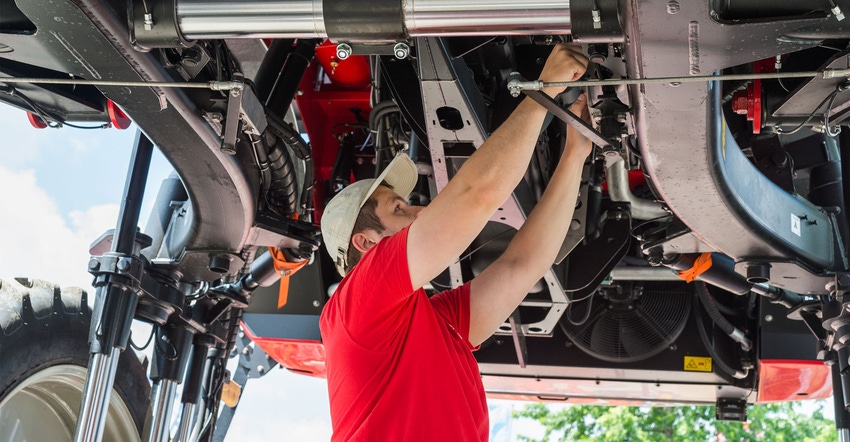
Every operational budget has plenty of moving parts — with none more literal than farm equipment. Proper postharvest maintenance and storage are two good ways to ensure all those moving parts will be ready for another season of wear-and-tear next year.
Knowing that, what can farmers do to give these assets the wintertime protection they need? Alternately, when is it time to let a tractor or implement go and search for a replacement?
Make a list
Every good winter storage strategy starts with a checklist, says Kelvin Leibold, Extension farm management specialist with Iowa State University. Every farm equipment’s individual checklist will look a little different, but a top-to-bottom inspection of each machinery asset is a good way to formulate a plan of action.
Pay special attention to moving parts and fluids, he says. Belts, pulleys and bearings can accumulate a lot of wear-and-tear during use, for example. And double-check that engine oil, antifreeze and hydraulic fluid are at correct levels and tightly sealed — especially for equipment that may be sitting idle for long periods of time.
“You don’t want water collecting in those systems,” Leibold warns.
Likewise, it’s wise to inspect electrical systems for the same reason, he adds.
“The battery is the heart of the electrical system, but there’s also a whole world of electrical connectors throughout that can corrode,” he says.
Don’t forget to inspect equipment for damage from foreign objects, like rocks, that can cause hidden damage to components, such as threshing units.
Following the adage, “An ounce of prevention is worth a pound of cure,” Leibold suggests making timely inspections and repairs simply to avoid forgetting that you need to do them later.
“If you’re using a piece of equipment and notice something wrong, the best time to fix it is right away when it’s still fresh on your mind,” he says.
Cleanliness is also generally a good policy when it comes to postharvest equipment storage, notes Peter Ovrebo, supervisor of high-horsepower tractors for Agco. Mice chewing up electrical components is a problem that’s more prevalent than some may realize, he says.
“It can be trying and time-consuming to track down the issues they cause, even though it’s usually not difficult to fix,” he says.
But on the other end of the spectrum, being overly aggressive with an expensive pressure washer can cause just as many problems, Ovrebo adds.
“They can damage electrical components and even cut clean through wires in some instances, even though they clean great,” he says.
Track expenses
As a piece of farm equipment gets older, it accrues more repair and maintenance costs. Some of these expenses may be relatively small, while others may be relatively major, but they all add to the cost of ownership over time.
The question then becomes: When is it wise to cut losses on an old piece of equipment and trade it in? That answer is not often easy, so Ovrebo and Leibold both recommend keeping a running tally of expenses tracked to each machinery asset.
“Tracking is good, and so is evaluating those costs at the end of the year to make sure each piece of equipment is meeting your needs,” Ovrebo says. “Also, if you can spot frequent problems, that will help you better prepare with replacement parts to avoid downtime and field repair costs.”
Be sure to keep repair costs in perspective, he says. Some repair intervals might only show up every 1,000 or more hours, he notes. For example, a single major repair may spike a machine’s cost for a single year, but it can sometimes be treated as an anomaly that doesn’t drastically skew overall costs over its entire lifetime.
Keeping up with equipment manuals should go hand in hand with tracking repair and maintenance costs, Ovrebo adds.
“Manufacturer specs are created from extensive testing — not just to create busy work,” he says. “It may seem trivial sometimes, but it is always important.”
Even a small amount of “tractor TLC” can go a long way, Ovrebo says.
“Most modern farm equipment is seen as a long-term investment that is reliable for thousands of hours,” he says. “Stay up-to-date on service intervals to avoid more costs in the long run.”
DIY or dealer?
Each potential repair decision comes preloaded with a sometimes difficult-to-answer question: “Can I do it myself, or should I get outside help?”
Some farmers are more mechanically inclined than others, so the answer is often highly dependent on each individual’s precise skill set. But no matter where you land on that spectrum, it pays to establish and maintain regular communications with your dealer, says Agco’s Peter Ovrebo. “Not all work needs to be pushed to dealers, but you could be getting proactive updates and other helpful advice before problems occur,” he says.
More than a few farmers have turned to YouTube for inspiration and direction on any number of farm equipment repairs. Online instruction can indeed provide cost-effective solutions, but it may pay to proceed with caution, Ovrebo says.
“The Internet is great for finding self-maintenance help, but some nuances still exist,” he says. “Dealers will have the latest info from OEMs for the most correct, efficient repairs.”
About the Author(s)
You May Also Like






